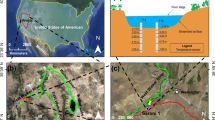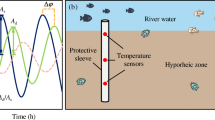Abstract
The hyporheic zone (HZ) is a saturated sediment layer connecting groundwater (GW) and surface water (SW) along a riverbed and river channel. The HZ plays an important role in connecting SW and GW in a river ecosystem, thereby helping maintain the ecological health of rivers. Studies on the HZ have therefore increased in many disciplines. This study used the VFLUX 2 software to assess vertical fluid flux in the HZ, in which the Hatch, Kerry, McCallum, and Luce models were applied and compared. The simulations were calibrated against data measured by the US Geological Survey at a water diversion channel within the Walker River Basin in Nevada. Using COMSOL Multiphysics, we developed a two-dimensional coupled numerical model of the saturated seepage and temperature fields, calibrated against measured temperature data. We also determined the vertical seepage velocity and compared the simulations with those of the analytical models in VFLUX 2. The results showed that the temperature field distribution of the HZ is obviously nonuniform in space. With a deeper monitoring point, the thermal response of each temperature measurement pointed to periodic temperature fluctuations of the SW, which exhibited attenuation and hysteresis characteristics. When the vertical flow velocity of GW was sufficiently large, an error in the accuracy of the Kerry model amplitude ratio was observed, regardless of the heat dispersion coefficient used. Under conditions of local GW recharge by SW and a heterogeneous permeability coefficient, the use of the amplitude ratio method is recommended to quantify the vertical GW flow rate in the HZ.









Similar content being viewed by others
References
Anderson MP (2005) Heat as a ground water tracer. Groundwater 43(6):951–968. https://doi.org/10.1111/j.1745-6584.2005.00052.x
Boano F, Harvey JW, Marion A, Packman AI, Revelli R, Ridolfi L, Wörman A (2014) Hyporheic flow and transport processes: mechanisms, models, and biogeochemical implications. Rev Geophys 52(4):603–679. https://doi.org/10.1002/2012RG000417
Brunner P, Therrien R, Renard P, Simmons CT, Franssen HJH (2017) Advances in understanding river-groundwater interactions. Rev Geophys 55(3):818–854. https://doi.org/10.1002/2017RG000556
Caissie D, Kurylyk BL, St-Hilaire A, El-Jabi N, MacQuarrie KTB (2014) Streambed temperature dynamics and corresponding heat fluxes in small streams experiencing seasonal ice cover. J Hydrol 519:1441–1452. https://doi.org/10.1016/j.jhydrol.2014.09.034
Cardenas MB (2015) Hyporheic zone hydrologic science: a historical account of its emergence and a prospectus. Water Resour Res 51(5):3601–3616. https://doi.org/10.1002/2015WR017028
Carsel RF, Parrish RS (1988) Developing joint probability distributions of soil water retention characteristics. Water Resour Res 24(5):755–769
Cetin M (2015) Using GIS analysis to assess urban green space in terms of accessibility: case study in Kutahya. Int J Sustain Dev World Ecol 22(5):420–424
Cetin M (2016) Determination of bioclimatic comfort areas in landscape planning: a case study of Cide Coastline. Turk J Agric-Food Sci Technol 4(9):800–804
Cetin M, Sevik H (2016) Assessing potential areas of ecotourism through a case study in Ilgaz Mountain National Park, InTech, Chapter 5, Eds:Leszek Butowski, 190, ISBN:978–953–51-2281-4, 81–110
Cetin M, Adiguzel F, Kaya O, Sahap A (2018a) Mapping of bioclimatic comfort for potential planning using GIS in Aydin. Environ Dev Sustain 20:361–375. https://doi.org/10.1007/s10668-016-9885-5
Cetin M, Onac AK, Sevik H, Canturk U, Akpinar H (2018b) Chronicles and geoheritage of the ancient Roman city of Pompeiopolis: a landscape plan. Arab J Geosci 11:798. https://doi.org/10.1007/s12517-018-4170-6
Cetin M, Sevik H, Canturk U, Cakir C (2018c) Evaluation of the recreational potential of Kutahya Urban Forest. Fresenius Environ Bull 27(5):2629–2634
Cetin M, Zeren I, Sevik H, Cakir C, Akpinar H (2018d) A study on the determination of the natural park’s sustainable tourism potential. Environ Monit Assess 190:167. https://doi.org/10.1007/s10661-018-6534-5
Constantz J (2008) Heat as a tracer to determine streambed water exchanges. Water Resour Res 44:W00D10. https://doi.org/10.1029/2008WR006996
Engelhardt I, Piepenbrink M, Trauth N, Stadler S, Kludt C, Schulz M, Schüth C, Ternes TA (2011) Comparison of tracer methods to quantify hydrodynamic exchange within the hyporheic zone. J Hydrol 400(1–2):255–266. https://doi.org/10.1016/j.jhydrol.2011.01.033
Engelhardt I, Prommer H, Moore C, Schulz M, Schuth C, Ternes TA (2013) Suitability of temperature, hydraulic heads, and acesulfame to quantify wastewater-related fluxes in the hyporheic and riparian zone. Water Resour Res 49(1):426–440. https://doi.org/10.1029/2012WR012604
Gordon RP, Lautz LK, Briggs MA, McKenzie JM (2012) Automated calculation of vertical pore-water flux from field temperature time series using the VFLUX method and computer program. J Hydrol 420:142–158. https://doi.org/10.1016/j.jhydrol.2011.11.053
Goto S, Yamano M, Kinoshita M (2005) Thermal response of sediment with vertical fluid flow to periodic temperature variation at the surface. J Geophys Res Solid Earth 110(B1):211–226. https://doi.org/10.1029/2004jb003419
Harvey J, Gooseff M (2015) River corridor science Hydrologic exchange and ecological consequences from bedforms to basins. Water Resour Res 51(9):6893–6922. https://doi.org/10.1002/2015WR017617
Hatch CE, Fisher AT, Revenaugh JS, Constantz J, Ruehl C (2006) Quantifying surface water-groundwater interactions using time series analysis of streambed thermal records: method development. Water Resour Res 42:W10410. https://doi.org/10.1029/2005WR004787
Healy RW, Ronan AD (1996) Documentation of computer program VS2DH for simulation of energy transport in variably saturated porous media; modification of the US geological survey’s computer program VS2DT. US Geological Survey, Denver
Hou Z, Nelson WC, Stegen JC, Murray CJ, Arntzen E, Crump AR, Kennedy DW, Perkins MC, Scheibe TD, Fredrickson JK, Zachara JM (2017) Geochemical and microbial community attributes in relation to hyporheic zone geological facies. Sci Rep 7:12006. https://doi.org/10.1038/s41598-017-12275-w
Irvine DJ, Cranswick RH, Simmons CT, Shanafield MA, Lautz LK (2015) The effect of streambed heterogeneity on groundwater-surface water exchange fluxes inferred from temperature time series. Water Resour Res 51(1):198–212. https://doi.org/10.1002/2014WR015769
Irvine DJ, Briggs MA, Lautz LK, Gordon RP, McKenzie JM, Cartwright I (2017) Using diurnal temperature signals to infer vertical groundwater-surface water exchange. Groundwater 55(1):10–26. https://doi.org/10.1111/gwat.12459
Kaya E, Agca M, Adiguzel F, Cetin M (2018) Spatial data analysis with R programming for environment. Hum Ecol Risk Assess: Int J:1–10. https://doi.org/10.1080/10807039.2018.1470896
Keery J, Binley A, Crook N, Smith JWN (2007) Temporal and spatial variability of groundwater-surface water fluxes: development and application of an analytical method using temperature time series. J Hydrol 336(1/2):1–16. https://doi.org/10.1016/j.jhydrol.2006.12.003
Lu CP, Chen S, Zhang Y, Su XR, Chen GH (2017) Heat tracing to determine spatial patterns of hyporheic exchange across a river transect. Hydrogeol J 25(6):1633–1646. https://doi.org/10.1007/s10040-017-1553-9
Luce C, Tonina D, Gariglio F, Applebee R (2013) Solutions for the diurnally forced advection-diffusion equation to estimate bulk fluid velocity and diffusivity in streambeds from temperature time series. Water Resour Res 49(1):488–506. https://doi.org/10.1029/2012WR012380
McCallum AM, Andersen MS, Rau GC, Acworth RI (2012) A 1-D analytical method for estimating surface water-groundwater interactions and effective thermal diffusivity using temperature time series. Water Resour Res 48:W11532. https://doi.org/10.1029/2012WR012007
Munz M, Oswald SE, Schmidt C (2016) Analysis of riverbed temperatures to determine the geometry of subsurface water flow around in-stream geomorphological structures. J Hydrol 539:74–87. https://doi.org/10.1016/j.jhydrol.2016.05.012
Mutiti S, Levy J (2010) Using temperature modeling to investigate the temporal variability of riverbed hydraulic conductivity during storm events. J Hydrol 388(3–4):321–334. https://doi.org/10.1016/j.jhydrol.2010.05.011
Naranjo RC, Smith DW (2016) Quantifying seepage using heat as a tracer in selected irrigation canals, Walker River Basin, Nevada, 2012 and 2013. Reston, U.S. Geological Survey
Rau GC, Andersen MS, McCallum AM, Roshan H, Acworth RI (2014) Heat as a tracer to quantify water flow in near-surface sediments. Earth Sci Rev 129:40–58. https://doi.org/10.1016/j.earscirev.2013.10.015
Ren J, Chen JQ, Yang J, Zhou YJ (2018a) A review on using heat as a tool for studying groundwater-surface water interactions. Environ Earth Sci 77(22):756. https://doi.org/10.1007/s12665-018-7959-4
Ren J, Wang XP, Shen ZZ, Zhao J, Yang J, Ye M, Zhou YJ, Wang ZH (2018b) Heat tracer test in a riparian zone: laboratory experiments and numerical modelling. J Hydrol 563:560–575. https://doi.org/10.1016/j.jhydrol.2018.06.030
Ren J, Zhang WB, Yang J, Shen ZZ, Zhao J, Zhou YJ, Wang ZH (2019a) A comparison of numerical and Lu modeling of water flow and heat transport with laboratory experiments. Environ Earth Sci 78(8):267. https://doi.org/10.1007/s12665-019-8269-1
Ren J, Zhang WB, Yang J, Zhou YJ (2019b) Using water temperature series and hydraulic heads to quantify hyporheic exchange in the riparian zone. Hydrogeol J 27(4):1419–1437. https://doi.org/10.1007/s10040-019-01934-z
Robertson AL, Wood PJ (2010) Ecology of the hyporheic zone: origins, current knowledge and future directions. Fund Appl Limnol 176(4):279–289. https://doi.org/10.1127/1863-9135/2010/0176-0279
Sawyer AH, Cardenas MB, Buttles J (2012) Hyporheic temperature dynamics and heat exchange near channel-spanning logs. Water Resour Res 48:W01529. https://doi.org/10.1029/2011WR011200
Sophocleous M (2002) Interactions between groundwater and surface water: the state of the science. Hydrogeol J 10:52–67. https://doi.org/10.1007/s10040-001-0170-8
Stallman RW (1965) Steady one-dimensional fluid flow in a semi-infinite porous medium with sinusoidal surface temperature. J Geophys Res 70(12):2821–2827. https://doi.org/10.1029/jz070i012p02821
Stonestrom DA, Constantz J (2003) Heat as a tool for studying the movement of ground water near streams. Reston, US Department of the Interior, US Geological Survey
Wilson AM, Woodward GL, Savidge WB (2016) Using heat as a tracer to estimate the depth of rapid porewater advection below the sediment-water interface. J Hydrol 538:743–753. https://doi.org/10.1016/j.jhydrol.2016.04.047
Winter TC (1995) Recent advances in understanding the interaction of groundwater and surface water. Rev Geophys 33(S2):985–994. https://doi.org/10.1029/95RG00115
Wondzell SM (2015) Groundwater-surface-water interactions: perspectives on the development of the science over the last 20 years. Freshw Sci 34(1):368–376. https://doi.org/10.1086/679665
Zhu JS, Shu LQ, Lu CP (2013) Study on the heterogeneity of vertical hyporheic flux using a heat tracing method. J Hydraul Eng 44(7):818–825 (in Chinese)
Acknowledgments
We are grateful to the US Geological Survey of Nevada for sharing the data needed in this study. We thank the precious suggestions by anonymous reviewers and editors, which have greatly helped in the improvement of the paper.
Funding
This work was supported by the National Natural Science Foundation of China (Grant No. 51679194, 51509014), the Planning Project of Science and Technology of Water Resources of Shaanxi (Grant No. 2019slkj-12), and the State Key Laboratory of Eco-hydraulics in Northwest Arid Region (Xi’an University of Technology) (Grant No. 2019KJCXTD-10).
Author information
Authors and Affiliations
Corresponding author
Ethics declarations
Conflict of interest
The authors declare that they have no conflict of interest.
Additional information
Responsible Editor: Tajudeen Iwalewa
Rights and permissions
About this article
Cite this article
Ren, J., Cheng, J., Zhang, W. et al. Vertical fluid flux in the hyporheic zone: field investigation, model, and comparative analysis. Arab J Geosci 13, 9 (2020). https://doi.org/10.1007/s12517-019-4990-z
Received:
Accepted:
Published:
DOI: https://doi.org/10.1007/s12517-019-4990-z




